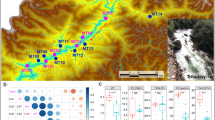Abstract
Investigations of Baikalian phytoplankton in 1960s showed that some very small blue-green algae with a cell diameter of 1.5 μm develop in great abundance in Lake Baikal in summer. They were described as a new endemic species – Synechocystis limnetica Popovsk. S. limnetica was found as mass dominant species of the autotrophic picoplankton. Knowledge on species composition of Baikalian picoplankton is limited to this species. Autotrophic picoplankton (APP) communities were studied monthly from 1997 to 2001 at the monitoring station in southern Lake Baikal. Microscopic examinations of picoplanktonic samples based on the fluorescence of pigments, cell morphology and ultrastructure revealed that Lake Baikal АРР is dominated by chroococcoid phycoerythrin-rich cyanobacteria of genus Synechococcus. Cyanobacteria of this genus were represented by various morphotypes throughout the study: coccoid and ellipsoid Synechococcus spp. 0.85 × 1.1 μm by size, constituting the main mass of autotrophic picoplankton, their proportion varying during the year from 74 to 97%; Synechococcus-species with short and long rod-shaped form of cells, reach maximum (8–18%) in the autumnal period. Endemic species of Lake Baikal – S. limnetica contribute 1–4% in APP communities. Baikalian APP was found to include free aggregated cells of Synechocystis- and Synechococcus-type, to 5% in autumn, as well as the colonial species Aphanothece clathrata f. brevis, the contribution of which to total autotrophic picoplankton fraction changes significantly in seasonal and annual aspects. Picoplanktonic green algae are not especially abundant in Lake Baikal, and, on average did not exceed 8% of the total APP. The sizes of picoalgae are 1.25 × 1.75 μm, both single cells of green algae; aggregated forms are noted in the picoplankton. Maximal abundance of autotrophic picoplankton was registered in a near-surface layer in late July (7.36 × 105 cells ml−1), and the minimum number (2.03 × 104 cells ml−1) in May, during the period of spring isothermal mixing.
Similar content being viewed by others
References
Albertano P., D. Di Somma, E. Capucci, 1997. Cyanobacterial picoplankton from the Central Baltic Sea: cell size classification by image-analyzed fluorescence microscopy. Journal of Plankton Research 10: 1405–1416.
Atlaschkin, V. V., O. I. Belykh & S. I. Belikov, 2000. Picoplanktonic green algae from Lake Baikal: morphology, ultrastructure and rbcL gene sequences. Proc. Int. Symp. “Biodiversity and dynamics of ecosystems in North Eurasia”, Novosibirsk, August 21–26, 2000. 5: 158–160.
Belykh O. I., E. I. Zaika, E. V. Berezikov, 1999. Autotrophic picoplankton of Lake Baikal. Sib. J. Ecol. 6: 35–39. .
Belykh O. I., E. A. Semenova, E. I. Zaika, K. D. Kuznedelov, N. E. Guselnikova, 2000. A eukaryotic alga from picoplankton of Lake Baikal: morphology, ultrastructure and rDNA sequence data. Hydrobiologia 435: 83–90.
Bondarenko N. A., N. E. Guselnikova, 1989. Primary production of phytoplankton in southern Lake Baikal. Izvestiya SO RAN, Biol. Science 1: 77–80 (In Russian).
Boraas M. E., D. W. Bolgrien, D. A. Holen, 1991. Determination of eubacterial size and cyanobacterial size and number in Lake Baikal using epifluorescence. International Review of Hydrobiology. 76: 537–544.
Campbell L., E. J. Carpenter, 1987. Characterization of phycoerythrin-containing Synechococcus spp. populations by immunofluorescence. Journal of Plankton Research 9: 1167–1181
Fahnenstiel G. L., H. J. Carrick, 1992. Phototrophic picoplankton in Lakes Huron and Michigan: abundance, distribution, composition, and contribution to biomass and production. Canadian Journal of Fisheries and Aquatic Science 49: 379–388.
Gollerbakh, M. M., E. K. Kosinskaya & V. I. Polyanskij, 1953. Key to freshwater algae of USSR. Blue-green algae. Gollerbakh, M. M., V. I. Polyanskij & V. P. Savich (eds). Sov. nauka, Moscow (in Russian) 652 pp.
Izmest’eva L. R. & O. M. Kozhova, 1988. Phytoplankton structure and succession. In Long-term prognosis of ecosystems state. Nauka, Novosibirsk, 97–129 (in Russian).
Komarek J., 1976. Taxonomic review of the genera Synechocystis Sauv. 1892, Synechococcus Näg. 1849, and Cyanothece gen. nov. (Cyanophyceae). Arch Protistenk 118: 119–179.
Kozhova O. M., 1987. Phytoplankton of Lake Baikal: structural and functional characteristics. Arch Hydrobiol Beih Ergebn Limnol Stuttgart 25: 19–37.
Kuzmin, G. V., 1975. Phytoplankton. In Procedures of Studying Biogeocenoses in Inner Waters. Nauka, Moscow, 73–84 (in Russian).
Nagata T., K. Takai, K. Kawanobe, D.-S. Kim, R. Nakazato, N. Guselnikova, N. Bondarenko, O. Mologawaya, T. Kostornova, V. Drucker, Y. Satoh, Y. Watanabe, 1994. Autotrophic picoplankton in southern Lake Baikal: abundance, growth and grazing mortality during summer. Journal of Plankton Research 16: 945–959.
Popovskaya G. I., 1968. Species nova Synechocystidis Sauv. in plancto lacus Baikal. Novitates systematicae plantarum non vascularium 5: 3–5.
Popovskaya, G. I., 1991. Phytoplankton of Lake Baikal and its long-term changes (1958–1990). PhD dissertation II (biology). Novosibirsk (in Russian) 45 pp
Sieburth J., McN. Smetacek, J. Lenz, 1978. Pelagic ecosystem structure: heterotrophic compartments of the plankton and their relationship to plankton size fractions. Limnology and Oceanography 23: 1256–1263.
Sime-Ngando T., 1995. Population dynamics of autotrophic picoplankton in relation to invironmental factors in a productive lake. Aquatic Science 2: 91–105.
Søndergaard M., 1991. Phototrophic picoplankton in temperate lakes: seasonal abundance and importance along a trophic gradient. International Review of Hydrobiology 76: 545–554.
Stockner J. G., 1991. Autotrophic picoplankton in freshwater ecosystem: the view from summit. International Review of Hydrobiology 76: 595–604.
Stockner J. G., N. J. Antia, 1986. Algal picoplankton from marine and freshwater ecosystems: a multidisciplinary perspective. Canadian Journal of Fisheries and Science 43: 2472–2503.
Votintsev K. K., G. I. Popovskaya, G. E. Mazepova, 1963. Physical chemistry regime and plankton life of shallow-water Selenga region of Lake Baikal. Trudy Limnol. Inst. 7: 321 (In Russian).
Votintsev K. K., A. I. Mescheryakova, G. I. Popovskaya, 1975. Cycle of Organic Matter in Lake Baikal. Nauka, Novosibirsk, pp 188 (In Russian).
Author information
Authors and Affiliations
Corresponding author
Rights and permissions
About this article
Cite this article
Belykh, O.I., Ekaterina, G., Sorokovikova, T. et al. Autotrophic picoplankton of Lake Baikal: composition, abundance and structure. Hydrobiologia 568 (Suppl 1), 9–17 (2006). https://doi.org/10.1007/s10750-006-0340-8
Issue Date:
DOI: https://doi.org/10.1007/s10750-006-0340-8




